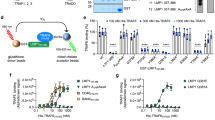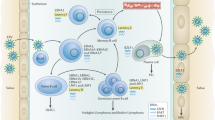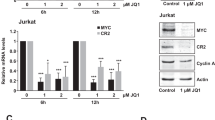Abstract
Epstein-Barr virus (EBV) is an oncogenic virus associated with a number of human malignancies including Burkitt lymphoma, nasopharyngeal carcinoma, lymphoproliferative disease and, though still debated, breast carcinoma. A subset of latent EBV antigens is required for mediating immortalization of primary B-lymphocytes. Here we demonstrate that the carboxy-terminal region of the essential latent antigen, EBNA-3C, interacts specifically with the human metastatic suppressor protein Nm23-H1. Moreover, EBNA-3C reverses the ability of Nm23-H1 to suppress the migration of Burkitt lymphoma cells and breast carcinoma cells. We propose that EBNA-3C contributes to EBV-associated human cancers by targeting and altering the role of the metastasis suppressor Nm23-H1.
This is a preview of subscription content, access via your institution
Access options
Subscribe to this journal
Receive 12 print issues and online access
$209.00 per year
only $17.42 per issue
Buy this article
- Purchase on Springer Link
- Instant access to full article PDF
Prices may be subject to local taxes which are calculated during checkout






Similar content being viewed by others
References
Kieff, E. Epstein-Barr Virus and Its Replication, 2343–2397 (Lippincott-Raven, Philadelphia, Pennsylvania, 1996).
Rickinson, A.B. & Kieff, E. Epstein-Barr Virus, 2397–2447 (Lippincott-Raven, Philadelphia, Pennsylvania, 1996).
Bonnet, M. et al. Detection of Epstein-Barr virus in invasive breast cancers. J. Natl. Cancer Inst. 91, 1376–1381 (1999).
Brink, A.A., van Den Brule, A.J., van Diest, P. & Meijer, C.J. Re: Detection of Epstein-Barr Virus in invasive breast cancers. J. Natl. Cancer Inst. 92, 655 (2000).
Cohen, J.I., Wang, F., Mannick, J. & Kieff, E. Epstein-Barr virus nuclear protein 2 is a key determinant of lymphocyte transformation. Proc. Natl. Acad. Sci. USA 86, 9558–9562 (1989).
Kaye, K.M., Izumi, K.M. & Kieff, E. Epstein-Barr virus latent membrane protein 1 is essential for B-lymphocyte growth transformation. Proc. Natl. Acad. Sci. USA 90, 9150–9154 (1993).
Tomkinson, B., Robertson, E. & Kieff, E. Epstein-Barr virus nuclear proteins EBNA-3A and EBNA-3C are essential for B-lymphocyte growth transformation. J. Virol. 67, 2014–2025 (1993).
Swaminathan, S., Tomkinson, B. & Kieff, E. Recombinant Epstein-Barr virus with small RNA (EBER) genes deleted transforms lymphocytes and replicates in vitro. Proc. Natl. Acad. Sci. USA 88, 1546–50 (1991).
Reisman, D., Yates, J. & Sugden, B. A putative origin of replication of plasmids derived from Epstein-Barr virus is composed of two cis-acting components. Mol. Cell. Biol. 5, 1822–1832 (1985).
Robertson, E.S. The Epstein-Barr Virus EBNA3 protein family as regulators of transcription. Epstein-Barr Virus Report 4, 143–150 (1997).
Mitchell, P.J. & Tjian, R. Transcriptional regulation in mammalian cells by sequence-specific DNA binding proteins. Science 245, 371–378 (1989).
Sample, J. et al. Epstein-Barr virus types 1 and 2 differ in their EBNA-3A, EBNA-3B, and EBNA-3C genes. J. Virol. 64, 4084–4092 (1990).
Vinson, C.R., Sigler, P.B. & McKnight, S.L. Scissors-grip model for DNA recognition by a family of leucine zipper proteins. Science 246, 911–916 (1989).
Allday, M.J. & Farrell, P.J. Epstein-Barr virus nuclear antigen EBNA3C/6 expression maintains the level of latent membrane protein 1 in G1-arrested cells. J. Virol. 68, 3491–3498 (1994).
Marshall, D. & Sample, C. Epstein-Barr virus nuclear antigen 3C is a transcriptional regulator. J. Virol. 69, 3624–3630 (1995).
Robertson, E.S. et al. Epstein-Barr virus nuclear protein 3C modulates transcription through interaction with the sequence-specific DNA-binding protein Jκ. J. Virol. 69, 3108–3116 (1995).
Robertson, E.S., Lin, J. & Kieff, E. The amino-terminal domains of Epstein-Barr virus nuclear proteins 3A, 3B, and 3C interact with RBPJ(κ). J. Virol. 70, 3068–3074 (1996).
Steeg, P.S., Bevilacqua, G., Pozzatti, R., Liotta, L.A. & Sobel, M.E. Altered expression of NM23, a gene associated with low tumor metastatic potential, during adenovirus 2 Ela inhibition of experimental metastasis. Cancer Res. 48, 6550–6554 (1988).
Lacombe, M.-L., Milon, L., Munier, A., Mehus, J.G. & Lambeth, D.O. The human Nm23/nucleoside diphosphate kinases. J. Bioenerg. Biomembr. 32, 247–258 (2000).
de la Rosa, A., Williams, R.L. & Steeg, P.S. Nm23/nucleoside diphosphate kinase: toward a structural and biochemical understanding of its biological functions. Bioessays 17, 53–62 (1995).
Hartsough, M.T. & Steeg, P.S. Nm23/Nucleoside Diphosphate Kinase in Human Cancers. J. Bioenerg. Biomembr. 32, 301–308 (2000).
Leone, A. et al. Reduced tumor incidence, metastatic potential, and cytokine responsiveness of nm23-transfected melanoma cells. Cell 65, 25–35 (1991).
Leone, A. et al. Evidence for nm23 RNA overexpression, DNA amplification and mutation in aggressive childhood neuroblastomas. Oncogene 8, 855–865 (1993).
Lim, S., Lee, H.Y. & Lee, H. Inhibition of colonization and cell-matrix adhesion after nm23-H1 transfection of human prostate carcinoma cells. Cancer Lett. 133, 143–149 (1998).
Russell, R.L. et al. Relationship of nm23 to proteolytic factors, proliferation and motility in breast cancer tissues and cell lines. Br. J. Cancer 78, 710–717 (1998).
Webb, P.A., Perisic, O., Mendola, C.E., Backer, J.M. & Williams, R.L. The crystal structure of a human nucleoside diphosphate kinase, NM23-H2. J. Mol. Biol. 251, 574–587 (1995).
Martin, K.K. & Pilkington, G.J. Nm23: an invasion suppressor gene in CNS tumours? Anticancer Res 18, 919–26 (1998).
Hailat, N. et al. High levels of p19/nm23 protein in neuroblastoma are associated with advanced stage disease and with N-myc gene amplification. J. Clin. Invest. 88, 341–345 (1991).
MacDonald, N.J., de la Rosa, A. & Steeg, P.S. The potential roles of nm23 in cancer metastasis and cellular differentiation. Eur. J. Cancer 31A, 1096–1100 (1995).
Harper, J.W., Adami, G.R., Wei, N., Keyomarsi, K. & Elledge, S.J. The p21 Cdk-interacting protein Cip1 is a potent inhibitor of G1 cyclin-dependent kinases. Cell 75, 805–816 (1993).
Speck, P. & Longnecker, R. Infection of Breast Epithelial Cells With Epstein-Barr Virus Via Cell-to-Cell Contact. J. Natl. Cancer Inst. 92, 1849–1851 (2000).
Zhao, B. & Sample, C.E. Epstein-barr virus nuclear antigen 3C activates the latent membrane protein 1 promoter in the presence of Epstein-Barr virus nuclear antigen 2 through sequences encompassing an spi-1/Spi-B binding site. J. Virol. 74, 5151–5160 (2000).
Leone, A., Flatow, U., VanHoutte, K. & Steeg, P.S. Transfection of human nm23-H1 into the human MDA-MB-435 breast carcinoma cell line: effects on tumor metastatic potential, colonization and enzymatic activity. Oncogene 8, 2325–2333 (1993).
Wang, L., Patel, U., Ghosh, L., Chen, H.C. & Banerjee, S. Mutation in the nm23 gene is associated with metastasis in colorectal cancer. Cancer Res. 53, 717–20 (1993); erratum: 53, 3652 (1993).
Labrecque, L.G., Barnes, D.M., Fentiman, I.S. & Griffin, B.E. Epstein-Barr virus in epithelial cell tumors: a breast cancer study. Cancer Res. 55, 39–45 (1995).
Glaser, S.L., Ambinder, R.F., DiGiuseppe, J.A., Horn-Ross, P.L. & Hsu, J.L. Absence of Epstein-Barr virus EBER-1 transcripts in an epidemiologically diverse group of breast cancers. Int. J. Cancer 75, 555–558 (1998).
Freije, J.M., MacDonald, N.J. & Steeg, P.S. Nm23 and tumour metastasis: basic and translational advances. Biochem. Soc. Symp. 63, 261–271 (1998).
Wagner, P.D., Steeg, P.S. & Vu, N.D. Two-component kinase-like activity of nm23 correlates with its motility-suppressing activity. Proc. Natl. Acad. Sci. USA 94, 9000–9005 (1997).
Kantor, J.D., McCormick, B., Steeg, P.S. & Zetter, B.R. Inhibition of cell motility after nm23 transfection of human and murine tumor cells. Cancer Res. 53, 1971–1913 (1993).
Liu, F., Qi, H.L. & Chen, H.L. Effects of all-trans retinoic acid and epidermal growth factor on the expression of nm23-H1 in human hepatocarcinoma cells. J. Cancer Res. Clin. Oncol. 126, 85–90 (2000).
Miller, W.E., Earp, H.S. & Raab-Traub, N. The Epstein-Barr virus latent membrane protein 1 induces expression of the epidermal growth factor receptor. J. Virol. 69, 4390–4398 (1995).
Albelda, S.M. et al. Integrin distribution in malignant melanoma: association of the beta 3 subunit with tumor progression. Cancer Res. 50, 6757–6764 (1990).
Filardo, E.J., Brooks, P.C., Deming, S.L., Damsky, C. & Cheresh, D.A. Requirement of the NPXY motif in the integrin beta 3 subunit cytoplasmic tail for melanoma cell migration in vitro and in vivo. J. Cell Biol. 130, 441–450 (1995).
Huang, S., Stupack, D., Liu, A., Cheresh, D. & Nemerow, G.R. Cell growth and matrix invasion of EBV-immortalized human B lymphocytes is regulated by expression of alphav integrins [In Process Citation]. Oncogene 19, 1915–1923 (2000).
Hajra, K.M., Ji, X. & Fearon, E.R. Extinction of E-cadherin expression in breast cancer via a dominant repression pathway acting on proximal promoter elements. Oncogene 18, 7274–7279 (1999).
MacDonald, N.J. et al. A serine phosphorylation of Nm23, and not its nucleoside diphosphate kinase activity, correlates with suppression of tumor metastatic potential. J. Biol. Chem. 268, 25780–25789 (1993).
Cotter, M.A., 2nd & Robertson, E.S. Modulation of histone acetyltransferase activity through interaction of Epstein-Barr nuclear antigen 3C with prothymosin α. Mol. Cell Biol. 20, 5722–5735 (2000).
Gulley, M.L., Raphael, M., Lutz, C.T., Ross, D.W. & Raab-Traub, N. Epstein-Barr virus integration in human lymphomas and lymphoid cell lines. Cancer 70, 185–191 (1992).
Acknowledgements
We thank E. Kieff for the EBNA-3C reagents; V. Deretic and J. Poschet for their support and their use of his fluorescence microscopy system; E. Fearon for the MDA-MB-435 cell line; P.S. Steeg and M.T. Hartstough for the pET3C-NM23H1 and pCMV-NM23-H1 constructs; and E. Postel for the NM23-H2 construct. This work was supported by grants from the Leukemia and Lymphoma Society of America and the National Cancer Institute CA072150-01 (to E.S.R.).
Author information
Authors and Affiliations
Corresponding author
Rights and permissions
About this article
Cite this article
Subramanian, C., Cotter, M. & Robertson, E. Epstein-Barr virus nuclear protein EBNA-3C interacts with the human metastatic suppressor Nm23-H1: A molecular link to cancer metastasis. Nat Med 7, 350–355 (2001). https://doi.org/10.1038/85499
Received:
Accepted:
Issue Date:
DOI: https://doi.org/10.1038/85499
This article is cited by
-
The metastasis suppressor protein NM23-H1 modulates the PI3K-AKT axis through interaction with the p110α catalytic subunit
Oncogenesis (2021)
-
Hepatitis C virus core protein interacts with cellular metastasis suppressor Nm23-H1 and promotes cell migration and invasion
Archives of Virology (2019)
-
NM23/NDPK proteins in transcription regulatory functions and chromatin modulation: emerging trends
Laboratory Investigation (2018)
-
Metastasis suppressors: functional pathways
Laboratory Investigation (2018)
-
Oncogenic Epstein–Barr virus recruits Nm23-H1 to regulate chromatin modifiers
Laboratory Investigation (2018)



